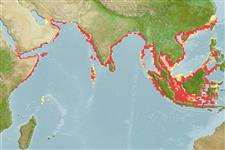Classification / Names
Common names from other countries
Main reference
Size / Weight / Age
Max length : 8.0 cm SL male/unsexed; (Ref. 1602)
Length at first maturity
Lm ?, range 6 - ? cm
Environment
Marine; brackish; reef-associated; oceanodromous (Ref. 51243); depth range 0 - 50 m (Ref. 189)
Climate / Range
Tropical, preferred ?; 28°N - 9°S, 42°E - 123°E (Ref. 189)
Distribution
Indo-Pacific: northern part of the Indian Ocean (Gulf of Aden, not Red Sea or the Persian Gulf, eastward to Burma) and western Pacific (Gulf of Thailand, Java Sea, also Hong Kong, Fujian and Taiwan Island; if correctly identified, then reaches to Fiji and Samoa) (Ref. 189). Mediterranean: Tel Aviv, Israel (Ref. 96660).
Countries | FAO areas | Ecosystems | Occurrences | Introductions
Short description
Dorsal
spines
(total): 0;
Anal
spines: 0;
Anal
soft rays: 14 - 17. Belly with 4 to 8 small needle-like scutes; a small pre-dorsal spine in some specimens. Maxilla tip pointed, reaching to or beyond hind border of pre-operculum, the latter concave, indented near maxilla tip. Fine teeth on upper edge of hyoid bones. A double pigment line on back behind dorsal fin; tail deep yellow (at least in Indian specimens).
IUCN Red List Status (Ref. 115185)
Threat to humans
Harmless
Human uses
Fisheries: commercial; bait: usually
More information
ReferencesAquacultureAquaculture profileStrainsGeneticsAllele frequenciesHeritabilityDiseasesProcessingMass conversion
Tools
Special reports
Download XML
Internet sources
Estimates of some properties based on models
Phylogenetic diversity index
PD50 = 0.5000 many relatives (e.g. carps) 0.5 - 2.0 few relatives (e.g. lungfishes)
Trophic Level
3.2 ±0.4 se; Based on size and trophs of closest relatives
Resilience
High, minimum population doubling time less than 15 months (K=1.61-20.8)
Vulnerability
Low vulnerability (10 of 100)
Price category
